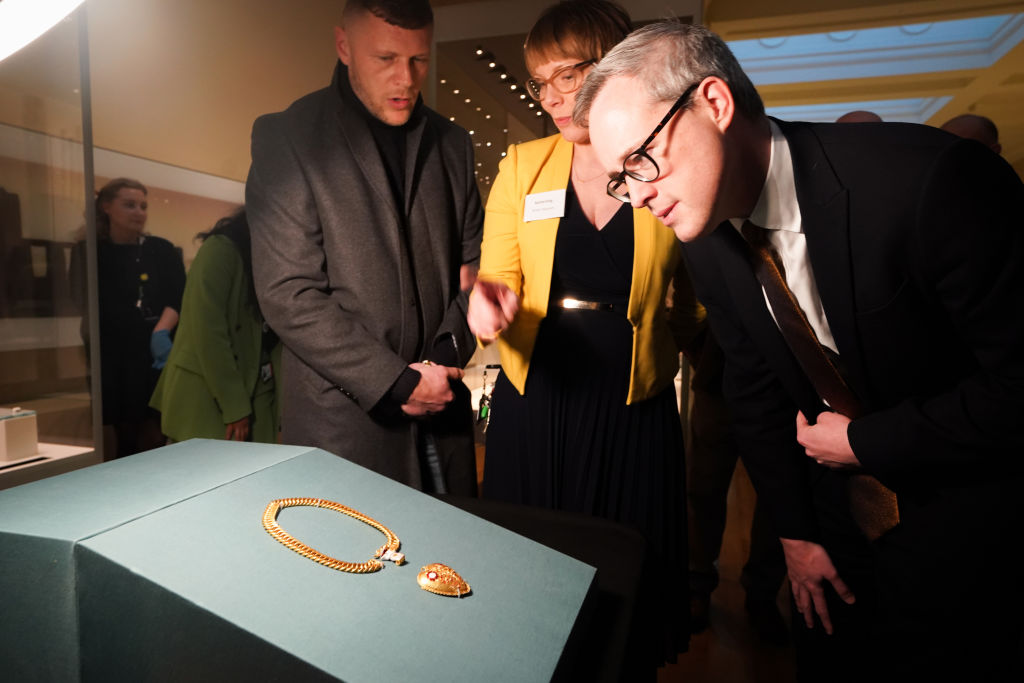It’s a once-in-a-lifetime find for any metal detectorist.

Charlie Clarke, a café owner from Birmingham, England, was mourning the death of his dog in 2019 and decided he’d take his metal detector out for a spin in a friend’s nearby field to get some fresh air and raise his spirits.
He’d only been in possession of his metal detector for about six months, but the 34-year-old amateur made an astonishing find in the Warwickshire field.
“It was just outstanding,” Clarke told CNN. “Nobody thinks you’re ever going to pull out that, in my lifetime especially — I can imagine in 30 lifetimes.”
After turning up mostly “junk,” Clarke was about to call it quits when his detector started beeping loudly. He dug into the soil, about the depth of his elbow, and pulled out a large heart-shaped pendant attached to a gold chain.
The find, Clarke told The Guardian, made him scream “like a little schoolgirl, to be honest. My voice went pretty high-pitched.”
The piece of jewelry, he would recently come to learn, dates back more than 500 years and features the initials and symbols of King Henry VIII and his first wife, Katherine of Aragon.
The pendant is attached to a chain of 75 links and crafted out of 300 grams of 24-carat gold, reports The Guardian, and is decorated with a bush bearing the Tudor rose and a pomegranate, Katherine’s symbol.
On the other side, the initials H and K appear, intertwined by an engraved ribbon and on both sides the inscription of “TOVS + IORS” appears, a pun on the French word “toujours” meaning “always.”
“We all thought: My goodness, is this for real? Could this possibly be?” Rachel King, curator of Renaissance Europe for the British Museum, told The New York Times about the shockwave sent through museum staff when they received the piece for analysis.
Some were skeptical at first, she told The Guardian. Nothing of this size and importance from the Renaissance period has been discovered in the last 25 years.
In fact, she was so stunned by the find that when she first heard about it she had to sit down.
“It was such a challenge to me in the sense that could this be 19th century, could it be just costume jewelery?” she told CNN.
The British Museum carried out a variety of tests to determine the authenticity of the Tudor pendant, confirming that it’s definitely the real deal.
King said that some mystery remains about the necklace. It’s unclear why the pendant was made or who it belonged to, but they’ve hypothesized that it might have been worn or handed out as a prize at one of the jousts the king was known for hosting at the time.
“This object has just come out of the ground almost as if it dropped out of the sky,” King told CNN.
“We’ve got an opportunity to study an object that hasn’t been subject to all of these sorting processes that people have historically taken …. we’re getting something that is in a sense raw information.”
According to Smithsonian Magazine, Henry and Katherine were known to host an event called Field of Cloth of Gold, a two-and-a-half week festival that celebrated the friendship and alliance between France and England. Attendees would attend jousts, feasts, wrestling matches and more in the name of celebration.
It was a majestic and over-the-top affair — Smithsonian estimates that in today’s dollars, it would have cost approximately US$19 million to hold the festivities — and many have guessed that the unearthed pendant may be a relic from the travelling event.
A press release about the pendant says the piece was likely hastily produced around 1521, and is similar to designs that were used on horse bards at a joust in Greenwich that same year.
“Nonetheless, its quality is such that it was certainly either commissioned by or somehow related to a member of the higher nobility or a high-ranking courtier,” King told The Guardian.
The pendant will remain in the possession of the British Museum, for now, and will be added to their collection of civilian-found archeological artifacts.
While it has not yet been valued, Clarke says he will split the earnings with the landowner of the field where the discovery was made.
- California mom accidentally invites 487 people to child’s 1st birthday
- ‘Hiroshima-level casualties’ feared in final battle for North Darfur
- Canada is unblocking aid to Afghanistan but delay is ‘extremely frustrating’: advocate
- Andrew Tate to stand trial on trafficking, rape charges in Romanian court












Comments